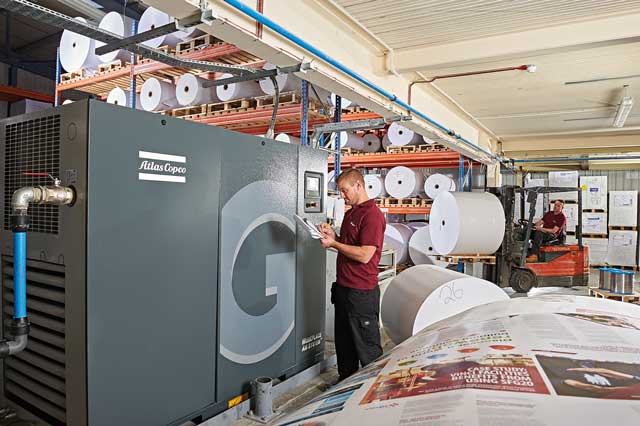 Stef Lievens, business line manager for industrial air at Atlas Copco Compressors UK & Ireland, outlines the key steps to follow to make sure a compressor is optimised for performance and energy-efficiency.
Stef Lievens, business line manager for industrial air at Atlas Copco Compressors UK & Ireland, outlines the key steps to follow to make sure a compressor is optimised for performance and energy-efficiency.
When you specify a new compressor, there are a wide range of factors to take into account. Making sure of the right choice of product, and supplier, will depend on the actual application’s needs for a compressed air supply, quantified for compressor size, flow, pressure, air quality and use patterns. These variables then need to be matched to the available types of compressor technologies and their relative performance, taking into consideration output, energy efficiency and total cost of ownership.
Replacing an existing compressor with a new state-of-the-art solution requires being armed with the relevant operational data and starting with an initial checklist such as these questions:
- What is the application?
- How much flow does the process use?
- What pressure is needed in the system?
- What air quality is needed? Is there a need for dryer and filters, or an oil-free solution, to guarantee a clean and dry air supply?
- How many hours per year will the compressor operate?
- What is the daily shift pattern?
- Should variable speed drive technology be considered, to cope with fluctuations in flow demand?
- Is heat recovery a consideration?
- Are there any plans for future expansion?
- What size compressor is needed?
The pressure required at the point of use, and the pressure drops in equipment and in the distribution system in an installation, determine the required working pressure of the system – including all the pipework, valves, dryers, receivers, and filters. The nominal air requirement is determined by all the individual air consumers − the tools, machines and processes – that will be connected, taking into account utilisation factors, and additions for leakage, wear, and future changes in the air requirement.
Compressor sizing: pressure + flow = energy = cost
When comparing like with like in a replacement scenario it is necessary to have at hand all the application and use information in order to size the machine correctly, and for comparison purposes.
Understanding the flow and pressure requirements for any installation is crucial. This correlation is important to bear in mind when determining the required size of a compressor based solely on its rated motor power. For example, a basic 7bar compressor driven by a 15kW motor will deliver air at a maximum volume of approximately 45 litre/s, but a 10bar version will deliver only 37 l/s from the same power unit. An increase in working pressure by 1bar increases the power requirement by approximately 6%. Also bear in mind competitive suppliers’ kW ranges are not always directly comparable.
Undersizing a compressor is likely to result in pressure drops and the inability to complete a task, while oversizing the unit can lead to future mechanical problems. Both can lead to excessive energy demands from the system.
Assessing a compressor system
When it is proposed to replace equipment, conducting an energy audit is seen as the definitive approach to identifying trends, establishing performance levels, and installing energy-efficient solutions. A walk-the-line compressed air assessment is the simplest and most cost-effective way to gain a better understanding of a compressed air system’s status.
Visual checks, carried out on the supply side of the compressor room as well as the demand side or the production floor, should include inspection of the compressor, dryer, filtration, and condensate drains, as well as the pipework system and its configuration.
Walk-through assessments may reveal the need for a full air audit, using dataloggers to provide an insight into the compressed air utilisation in a given system. Dataloggers are attached to the compressor for a minimum of 7-14 days to observe and record trends and demand fluctuation throughout normal weekdays as well as over the weekend.
Audit results provide a good understanding of the actual compressed air use over a period of time, identifying peaks and troughs in the air demand pattern and ways to improve the overall efficiency of the system.

